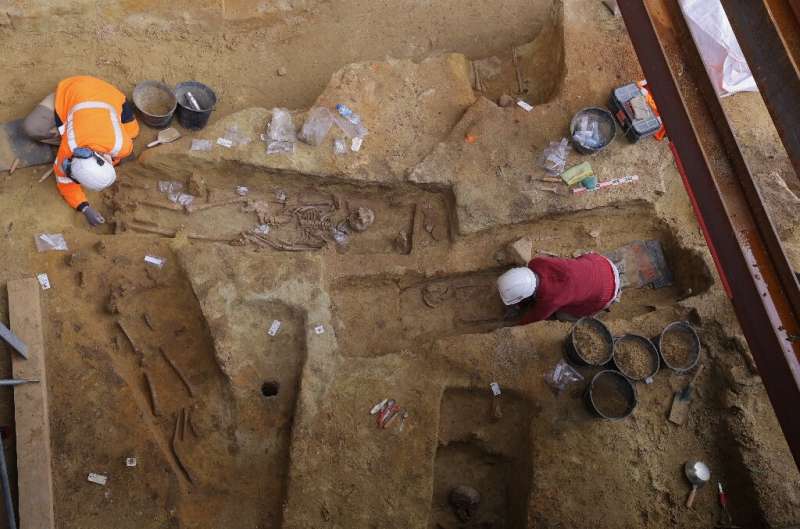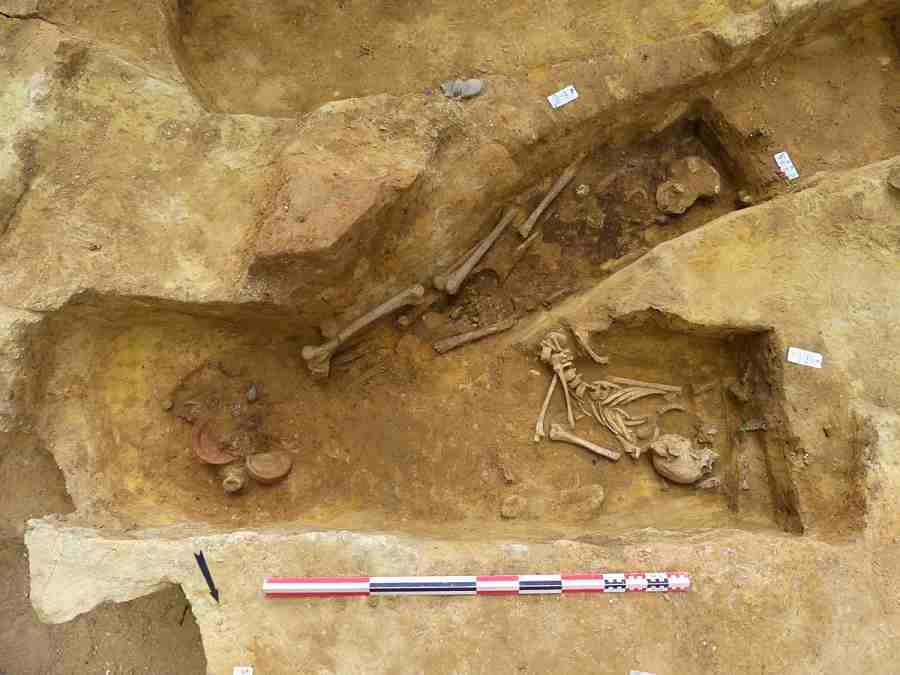![]() The graves are not uniformly oriented or sized. Image credit: Camille Colonna, INRAP
The graves are not uniformly oriented or sized. Image credit: Camille Colonna, INRAP
Mon 24 Apr 2023:
50 tombs of men, women, and children belonging to the second century CE have been discovered in a portion of an ancient necropolis discovered by archaeologists in the center of Paris.
While some of the necropolis was already known from 1800s investigations, the latest dig has uncovered a region that had not yet been exposed to excavation activity, uncovering artifacts and beliefs that had been buried beneath the city since antiquity.

A skeleton recovered at the Saint-Jacques necropolis. Image credit: Nicolas Warmé, INRAP
Despite numerous road construction projects over the years and the 1970s construction of the Port-Royal station on the historic Left Bank, the underground necropolis was somehow never discovered.
However, preparations for a new train station exit led to an archaeological dig.
Camille Colonna, an anthropologist at France’s National Institute of Preventive Archaeological Research (INRAP), told a press conference that there were already “strong suspicions” the site was close to Lutetia’s southern necropolis.
The “Saint Jacques” necropolis, the largest burial site in the Gallo–Roman town of Lutetia, was previously partially excavated in the 1800s.

An ancient “lacrymatory”, designed for collecting tears of mourners. Image credit: Camille Colonna, INRAP
It’s a time period from which just about anything is expected – and indeed, as a statement from France’s National Institute of Preventive Archaeological Research (INRAP) explains, “no organization or orientation seems predominant, and the digging of the sepulchral pits, sometimes of very large dimensions, both in length and in depth, is just as frequently narrow and leveled.”
But just as the necropolis stands out for this variety, so too is it notable for its uniformity: despite dating from a time when burials and cremations were both common, all 50 of the graves consisted of burials only.

A skull and ceramic goblet recovered at the dig. Image credit: Nicolas Warmé, INRAP
All were found in what were once coffins, with their shoes placed “either at the feet of the dead or next to them, like an offering,” noted Camille Colonna, an INRAP anthropologist, at a press conference on the dig, according to France24.
The remains of the men, women and children are believed to be Parisii, a Gallic people who lived in Lutetia, from when the town on the banks of the Seine river was under the control of the Roman Empire.
The skeletons were buried in wooden coffins, which were now only identifiable by their nails.

The leg bones of a skeleton plus ceramic grave goods. Image credit: Gwenaelle Desforges, INRAP
More than half were buried alongside offerings such as ceramic jugs and goblets.
Sometimes a coin was placed in the coffin, or even in the mouth of the dead, a common practice at the time called Charon’s obol.
In Greek mythology, Charon is the ferryman of Hades, and the coin was considered a bribe to carry the souls of the dead across the river Styx.
The archaeologists also found shoes inside the graves, identifying them by the small nails that would be been in the soles.
Jewelry, hairpins, belts were also discovered.

One of the skeletons unearthed in an ancient necropolis found metres from a busy Paris train station.

Archaeologists said the discovery would help understand the life of the Parisii nearly two thousand years ago.
The entire skeleton of a pig and another small animal was discovered in a pit where animals were thought to have been sacrificed to the gods.
Unlike the excavation in the 1800s, this time the team plans to remove everything from the necropolis for analysis.
“This will allow us to understand the life of the Parisii through their funeral rites, as well as their health by studying their DNA,” Colonna said.
Garcia said that the ancient history of Paris was “generally not well known”.
Ancient necropolis unearthed next to busy Paris train station
Just metres from a busy train station in the heart of Paris, scientists have uncovered 50 tombs in an ancient necropolis south of Lutetia, the precursor to the French capital, with numerous burials and offerings. pic.twitter.com/XJBKA9BNMs
— INDEPENDENT PRESS (@IpIndependent) April 23, 2023
SOURCE: INDEPENDENT PRESS AND NEWS AGENCIES
______________________________________________________________
FOLLOW INDEPENDENT PRESS:
TWITTER (CLICK HERE)
https://twitter.com/IpIndependent
FACEBOOK (CLICK HERE)
https://web.facebook.com/ipindependent
Think your friends would be interested? Share this story!





